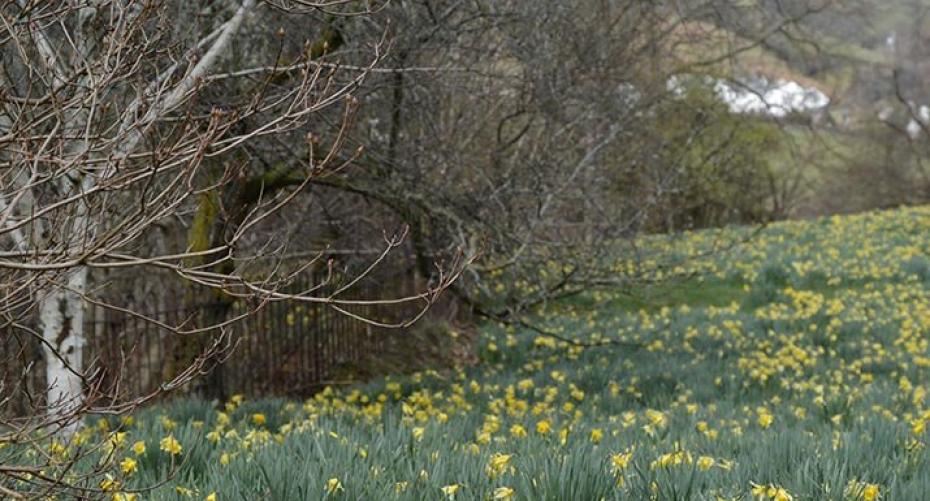Daffodils coming up blind is a common problem easily solved
Narcissus pseudonarcissus at Troutbeck churchyard, Windermere, Lake District
Daffodils which don’t flower, come up blind, still produce a lot of leaves and either no flowers or very few can be affected by several factors:
If they become too dry after they have flowered and before the leaves have yellowed and died back it can impair bud formation for the following year. Just make sure that you keep them well watered from planting in autumn, when they start their growth period, until the leaves have gone yellow and died back.

Narcissus 'Jumblie'
Cutting off the foliage after it has flowered prevents the plants from photosynthesising and making new buds and bulbs for the following year; knotting leaves also has the same effect. Leave the foliage until it has gone yellow, then you can remove it. If you have bulbs naturalised in grass make sure that you don’t mow until the leaves have yellowed.
Make sure that you take off the flower heads after they have gone over. If the plant is allowed to run to seed it puts its energy into producing seeds instead of building up the bulb and producing a new bud for the following year.
The soil can become depleted of nutrients by the bulbs being in the same place for years, this can affect the formation of the following year’s buds and bulbs. Feed with a slow release balanced fertiliser, such as Growmore, in the autumn then mulch with good quality peat-free compost or home-made garden compost. Feed weekly with Tomorite after flowering, this aids the formation of buds for the following year.
Bulbs planted too shallow will produce a lot of small bulbs which are too small to flower so make sure you plant them about 4 times their own height; about 10 – 15cm (4 – 6”) deep, depending upon the size of the bulb.

Narcissus mixed with Grape Hyacinth
Daffodils should be planted almost as soon as they come into the garden centres, usually mid-August. Try and get them into the ground by the end of September; leaving the planting too late in autumn can lead to them not flowering very well. However they should flower well the following year.
Overcrowding leads to too many plants competing for too few nutrients and is usually seen in clumps left to naturalise in woodland or in the lawn. Dig up in summer after the foliage has died back and split the clumps into individual bulbs and re-plant in the autumn, after improving the soil with some fresh compost and a feed of a balanced slow-release fertiliser. Clean the bulbs of soil and loose scales and store over summer somewhere cool and dark, and away from mice!
Pests such as narcissus eelworm or narcissus bulb fly can decimate the bulbs and unfortunately there is no cure. Another sign of pests and disease is the leaves having yellow blotches before they would naturally die back. Lift the bulbs and cut in half; check for the presence of larvae or eelworms. If the interior scales have gone brown and soft this is also often a sign of pests or disease. The only remedy is to dig them up, and all the bulbs within a metre radius. Destroy the bulbs by burning or putting into the grey wheelie bin, don’t put them onto the compost heap as this would just provide ideal conditions for the pests and fungi to multiply. It is also a good idea not to re-plant the same area with narcissus in case there is anything left in the soil.

Narcissus pseudonarcissus; excellent for naturalising in grass or under deciduous trees
Always choose large, good quality bulbs from a reputable supplier. Make sure they are firm, not soft and wrinkled, and that there are no patches of mould. Choose your bulbs as you would your onions in the supermarket, making sure they also have nice shiny outer scales.
Now is the time to start enjoying your garden, a strategically placed bench or bistro set is ideal for enjoying a bit of chill out time with your morning coffee or glass of something in the evening.
The Lake District is a riot of daffodils in spring so why not come for a ride out and check out all our fantastic blooms, including the famous Wordsworth daffodils. Pop into the store and try out our newly refurbished Four Seasons Restaurant, plus we have everything in store to get your garden summer ready.




![Kingsbury-bench-05[1].jpg](http://www.hayesgardenworld.co.uk/cdn/shop/files/Kingsbury-bench-05_5B1_5D.jpg?v=1712162737&width=1500)
![Kingsbury-bench-01[1].jpg](http://www.hayesgardenworld.co.uk/cdn/shop/files/Kingsbury-bench-01_5B1_5D.jpg?v=1712161065&width=1500)
![tw17a-4947_0[1].jpg](http://www.hayesgardenworld.co.uk/cdn/shop/files/tw17a-4947_0_5B1_5D.jpg?v=1712161495&width=1500)
![tw17a-4947_tenbury_5ft[1].jpg](http://www.hayesgardenworld.co.uk/cdn/shop/files/tw17a-4947_tenbury_5ft_5B1_5D.jpg?v=1712161172&width=1500)
![tw17a-4952_tenbury_4ft[1].jpg](http://www.hayesgardenworld.co.uk/cdn/shop/files/tw17a-4952_tenbury_4ft_5B1_5D.jpg?v=1712161034&width=1500)
![thumbnail_IMG_1565-kik_2[1].jpg](http://www.hayesgardenworld.co.uk/cdn/shop/files/thumbnail_IMG_1565-kik_2_5B1_5D.jpg?v=1712226536&width=1500)
![thumbnail_IMG_1565-kik_1[3].jpg](http://www.hayesgardenworld.co.uk/cdn/shop/files/thumbnail_IMG_1565-kik_1_5B3_5D.jpg?v=1712159637&width=1500)



![WD-XgESA[1].jpeg](http://www.hayesgardenworld.co.uk/cdn/shop/files/WD-XgESA_5B1_5D.jpg?v=1712159609&width=1500)